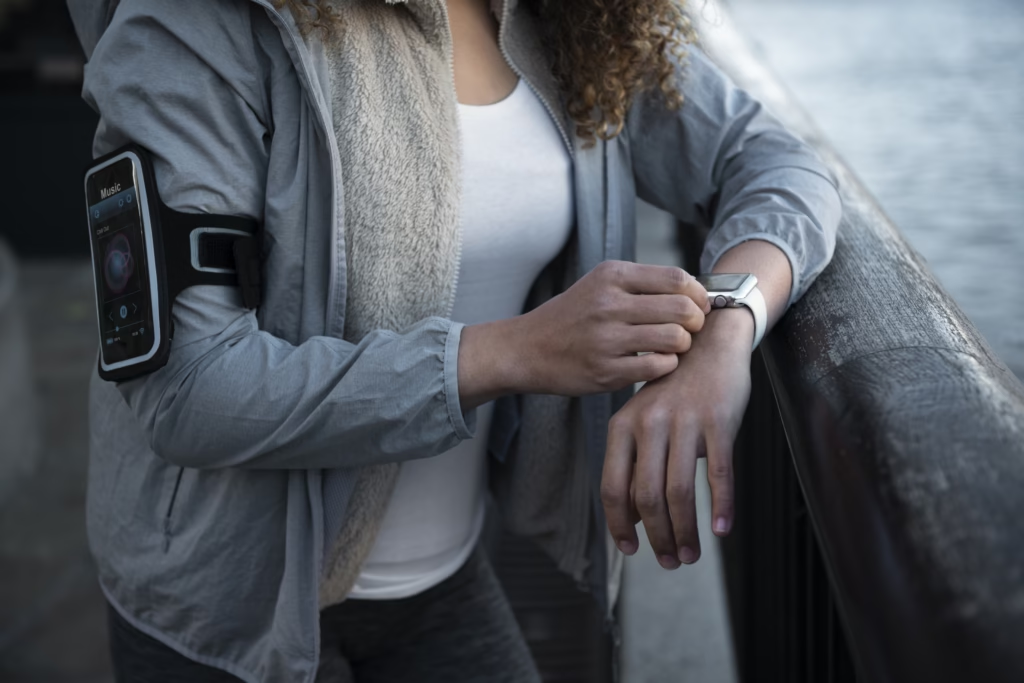Wearable Tech Trends 2025
Innovation in wearable tech trends is accelerating, with devices that go far beyond a flashy watch on your wrist. From sleek smart rings to interactive AR glasses and smart clothing, 2025 is ushering in a new generation of future wearables. These emerging tech platforms promise to reshape health tracking, daily convenience, and digital interaction in ways previously reserved for science fiction.
For context on how wearable hardware fits into broader consumer tech, refer back to: Wearable Tech Trends 2025: Beyond Smartwatches.
Table of Contents
1. Understanding the 2025 Wearable Landscape
Wearable tech trends are moving quickly from novelty applications into everyday essentials. The future wearables wave emphasizes minimalistic design with maximum function. Smartwatches now compete alongside smart rings, AR glasses, and biometric clothing.
Younger consumers and early adopters are prioritizing health tech wearables that seamlessly track sleep, stress, heart variability, and body temperature without interrupting their routine. Companies are redefining what it means to wear tech.
Understanding current categories helps businesses and consumers align buying decisions with long-term roadmap ensuring the right investments in smart rings, AR glasses, or smart clothing.
2. Smart Rings: Compact Powerhouses
Smart rings represent a breakthrough in wearable tech trends. These devices pack powerful sensors into rings that track heart rate, sleep quality, activity levels, and even blood oxygen all while being virtually invisible.
Compared to smartwatches, smart rings offer longer battery life, subtler form factor, and improved comfort. Popular 2025 models can deliver up to 7 days of battery from a single charge and are water-resistant for fitness or wellness users.
Use cases include biometric health monitoring during flights or meetings, pregnancy tracking, and discreet stress detection for professionals. Early adopters highlight how smart rings make monitoring effortless.
3. AR Glasses and Mixed Reality Wearables
Another major trend in future wearables is AR glasses, enabling overlay of digital content in real space. In 2025, models offer lightweight frames, long battery life, and integrations with voice assistants and smartphone apps.
Applications span navigation, on-the-job instructions, fitness coaching, or accessibility aids. For example, AR glasses can display step-by-step guidance for cooking, maintenance, or even language translation while on-the-go.
The rising capability makes AR glasses a key part of the evolving wearable tech ecosystem. They’re especially impactful in pro and enterprise contexts, including remote technical support and workplace safety.
4. Smart Clothing in 2025: Biometric Apparel
Smart clothing in 2025 goes well beyond smartwatches and rings. Embedded sensors now monitor posture, muscle activity, heart rate, and perspiration—all woven into everyday garments like shirts, bras, or yoga leggings.
These items pair with mobile apps to deliver real-time analytics and coaching. For athletes or fitness-conscious users, smart clothing provides form-correction feedback and injury prevention alerts.
Look for fabrics with washable electronics and long lifecycles. As adoption grows, smart clothing will bridge the gap between consumer convenience and advanced biometric insight.
5. Integrating Health Tech Wearables into Wellness
Health tech wearables are increasingly tied to broader wellness ecosystems. From sleep coaching and stress management to guided recovery and meditation content, devices become wellness companions, not just trackers.
Subscription models are emerging: wearable hardware bundled with monthly wellness plans that include personalized insights based on biometrics like HRV, sleep quality, and activity trends.
This trend strengthens the connection between devices and daily life utility. Consumers now expect seamless instructional guidance, context‑aware alerts, and integrations with diet or fitness platforms.
6. Consumer Use Cases & Adoption Trends
Consumers and professionals alike are finding compelling reasons to adopt future wearables. Smart rings appeal to executives wanting discreet biometrics. AR glasses assist technicians or hands‑on professionals. Smart clothing attracts athletes or posture-conscious users.
In healthcare, biometric apparel provides remote patient monitoring for cardiac and prenatal care. Employers also explore wearables to support employee wellness, reduce injuries, and optimize ergonomics.
These use cases underline the growth potential in wearable tech trends as hardware shifts from optional gadgets to everyday essentials across industries.
7. Smart Rings vs. Smartwatches: Which Wearable Is Right for You?
Explore Smart Rings vs. Smartwatches: Which Wearable Is Right for You? for an in-depth comparison.
In summary: smart rings offer discreteness, longer battery life, and sleep/stress monitoring convenience. Smartwatches deliver broader app ecosystems, screens, notifications, and richer interactivity.
Your choice depends on your priority: biometric health tracking and comfort, or versatile display interactions and app control. Many consumers use both in combination as a holistic wearable strategy.
8. Mini Case Studies of Wearable Deployments
Case Study A: Remote Patient Monitoring with Smart Clothing
A US-based chronic care clinic issued biometric shirts and smart bands to 100 patients. Real-time vitals streaming and AI‑driven alerts reduced hospitalization by 12% in six months.
Case Study B: Smart Ring for Executive Wellness
An executive wellness program provided smart rings to 50 executives. Monthly reports on sleep, HRV, and stress enabled coaching interventions. Productivity survey scores rose 15% after three months.
Case Study C: AR Glasses in Industrial Training
A manufacturing firm equipped maintenance teams with AR glasses for guided repairs. Visual overlays reduced error rates by 25% and training time was cut in half.
9. Frequently Asked Questions
Q1: What’s the main difference between smart rings and smartwatches?
Smart rings focus on subtle biometric tracking, long battery life, and comfort. Smartwatches offer larger displays, app ecosystems, and interactive control.
Q2: Are AR glasses ready for daily casual use in 2025?
Some models are light and stylish enough for casual wear, but broad adoption depends on app ecosystems and comfort improvements.
Q3: Can smart clothing be washed?
High-quality smart clothing is machine-washable or hand-washable up to specified temperatures. Electronics are typically removable or protected.
Q4: Do health‑tech wearables require subscriptions?
Many offer basic functionality for free but require paid plans for advanced analytics, coaching features, or cloud synchronization.
Q5: How secure is data from wearable devices?
Leading brands employ end‑to‑end encryption, anonymized data transmission, and strict privacy compliance. Users should review each provider’s data policies.
10. Conclusion & Strategic Outlook
Wearable tech trends in 2025 go well beyond smartwatches, with smart rings, AR glasses, and smart clothing redefining functionality in health, productivity, and daily convenience. These future wearables offer new touchpoints for tracking, feedback, and integration into wellness or professional workflows.
Decide which technology suits your needs based on use case: discreet biometric tracking? interactive digital overlays? or fitted sensors embedded in clothing? Your ideal wearable strategy may combine all three.
To dive deeper into choosing between options, read our comparison: Smart Rings vs. Smartwatches: Which Wearable Is Right for You? And for industry impact insights, explore How Wearable Tech Is Revolutionizing Health and Wellness.
Staying informed on these trends positions you at the forefront of next‑gen wearable experiences. Whether you’re a consumer, wellness coach, or technology leader, integrating these devices thoughtfully will keep you future-ready.


